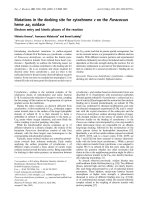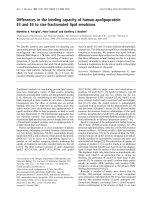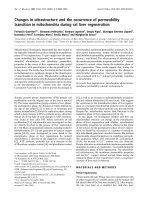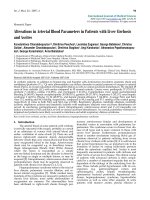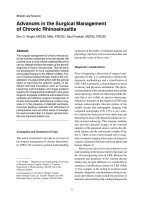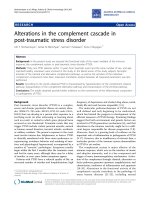Báo cáo y học: " Autoantibodies in vasculitis" pptx
Bạn đang xem bản rút gọn của tài liệu. Xem và tải ngay bản đầy đủ của tài liệu tại đây (60.29 KB, 6 trang )
147
AECA = antiendothelial cell antibody; ANA = antinuclear antibody; ANCA = antineutrophil cytoplasmic antibody; ELISA = enzyme-linked
immunosorbent assay; GBM = glomerular basement membrane; IIF = indirect immunofluorescence; MPO = myeloperoxidase; NCGN = necrotizing
and crescentic glomerulonephritis; NSA = neutrophil-specific autoantibody; PR3 = proteinase-3; SVV = small vessel vasculitis; WG = Wegener’s
granulomatosis.
Available online />Introduction
‘Vasculitis’ is the term used for inflammatory diseases that
involve blood vessel walls and the surrounding interstitium.
Vasculitis may affect large, medium and small sized arter-
ies, arterioles, capillaries, venules and veins [1]. Only the
vasculitides that involve arterioles, capillaries and venules
give rise to production of autoantibodies, which can serve
as practical surrogate markers of the condition in ques-
tion. Hence, the primary focus of the present review is on
autoantibodies that are characteristically found in small
vessel vasculitides [2].
The lack of a unified terminology and classification for the
various vasculitic conditions in the 1980s led to several
attempts to set up a clinically applicable nomenclature.
The American College of Rheumatology proposed classifi-
cation criteria for some primary vasculitides and advo-
cated the use of somewhat complicated diagnostic
algorithms for establishing a precise diagnosis for each
condition [3], but one clinically important vasculitic condi-
tion, namely microscopic polyangiitis [4], had been left
out. A simplified nomenclature for primary vasculitic condi-
tions, each one defined by their most common clinical, his-
tological and immunological characteristics, was
proposed by an ad hoc expert committee in 1994 [1]. This
so-called Chapel Hill terminology has been widely
accepted because of its simplicity and ease of use in clini-
cal work up and is therefore used in this review.
The antineutrophil cytoplasmic antibodies (ANCAs) directed
at proteinase-3 (PR3) and myeloperoxidase (MPO) were
discussed at length at the Chapel Hill Conference. That
they are very characteristic markers of systemic Wegen-
er’s granulomatosis (WG), Churg–Strauss syndrome and
microscopic polyangiitis (as well as limited forms of these
conditions, such as renal-limited necrotizing and crescen-
Review
Autoantibodies in vasculitis
Allan Wiik
Department of Autoimmunology, Statens Serum Institut, Copenhagen, Denmark
Corresponding author: Allan Wiik (e-mail: )
Received: 30 Jan 2003 Revisions requested: 24 Feb 2003 Revisions received: 5 Mar 2003 Accepted: 14 Mar 2003 Published: 9 Apr 2003
Arthritis Res Ther 2003, 5:147-152 (DOI 10.1186/ar758)
© 2003 BioMed Central Ltd (Print ISSN 1478-6354; Online ISSN 1478-6362)
Abstract
Before the mid-1980s the only autoantibody widely used to assist in diagnosing vasculitic disease was
IgG antibody to the α
3
domain of the noncollagenous part of type IV collagen (anti-glomerular
basement membrane). Since that time, antineutrophil cytoplasmic antibodies (ANCAs) directed at the
azurophilic granule proteins proteinase-3 and myeloperoxidase have been established as clinically
useful autoantibodies to support a diagnosis of Wegener’s granulomatosis, microscopic polyangiitis,
Churg–Strauss syndrome and limited forms of these primary, small vessel necrotizing and often
granulomatous vasculitides. The establishment of standardized methods for identifying those
antibodies was needed before they could be used in clinical practice. The levels of both types of
ANCAs tend to increase in parallel with the degree of clinical disease activity, and they decrease with
successful immunosuppressive therapy. More than one assay may have to be used to discover
imminent exacerbations in proteinase-3-ANCA associated syndromes. Although autoantibodies to
endothelial cells may be important players in the pathogenesis of several vasculitic conditions, they
have not gained clinical popularity because of lack of standardized detection methods.
Keywords: antiendothelial antibodies, antineutrophil cytoplasm antibodies, prognostics, vasculitis
148
Arthritis Research & Therapy Vol 5 No 3 Wiik
tic glomerulonephritis [NCGN]) was recognized, but it
was not proposed that they be included in the criteria for
these conditions.
The varying presentations of small vessel vasculitis (SVV)
necessitate close collaboration between many different
specialities in clinical medicine, as well as pathology and
immunology experts, if an early and precise diagnosis is to
be established that can serve as a rational basis for clini-
cal decisions (e.g. prognosis estimation, follow-up strategy
and therapy) [5]. What may appear to be a case of ANCA-
positive WG limited to the upper airways may turn out to
be a more systemic disease when the vasculitis team
becomes involved. Finding ANCAs in the serum of a
patient with seemingly skin-limited vasculitis can indicate
the presence of systemic SVV, and therefore the vasculitis
team should be involved to determine the disease extent
and help to locate sites that should be biopsied to confirm
the diagnosis. In contrast, generalized WG with severe
central nervous system manifestations may be consistently
negative for ANCAs [6]. The histopathological diagnosis
rests on the presence of necrotizing vasculitis involving
capillaries and venules but sometimes arterioles also,
whereas larger arteries are less frequently involved [2]. In
WG and Churg–Strauss syndrome perivascular granulo-
matous lesions with giant cells can be found in upper
airway biopsies and bronchi, but often the picture is domi-
nated by nonspecific inflammatory infiltrates [7]. Lesions in
the kidneys are typically those of focal NCGN without
immune deposits [8], sometimes termed pauci-immune
NCGN.
Antineutrophil cytoplasmic antibodies
The first description of ANCAs came from Australia, where
patients suffering from NCGN were found to harbour anti-
bodies that reacted with neutrophilic granulocyte cyto-
plasm by indirect immunofluorescence (IIF) using
ethanol-fixed human leucocytes as substrate [9]. These
findings were corroborated by a Dutch–Danish study of
patients with WG, most of whom had active systemic
disease, including nephritis [10]. The classical granular
cytoplasmic ANCA (C-ANCA) pattern [11] was found to
be caused by ANCAs directed against PR3 [12], and high
titers of C-ANCA were confirmed to be associated with
active systemic WG [13]. A majority of patients with
pauci-immune NCGN without a diagnosis of WG,
however, produced ANCAs that selectively stained the
perinuclear area of neutrophils and monocytes (P-ANCA)
[11], and these antibodies were found to be predomi-
nantly directed against MPO [14]. Furthermore, in these
patients, the levels of MPO-ANCA were dependent on
disease activity, with high levels being found in active
phases of the vasculitic disease [15].
These findings led to great interest in the practical use of
PR3-ANCA and MPO-ANCA as tools for diagnosing and
monitoring patients with SVV, but also gave rise to the
elaboration of various methods to demonstrate and quan-
tify these antibodies. It soon became apparent that differ-
ent methodologies led to very different results, and
therefore the First International Workshop on ANCAs was
established in Copenhagen in 1988. It was agreed to
identify one technique to be recommended for use when
sera are screened for ANCA using IIF [16]. Follow-up
studies revealed a clearly improved recognition of SVV-
associated ANCAs and reproducible classification of the
two IIF ANCA patterns, but not improved evaluation of
titers [17]. However, PR3-ANCA and MPO-ANCA deter-
mination was inconsistent and a European multicenter
project – the EC/BCR ANCA assay standardization study,
supported by the European Commission – was initiated to
achieve better standardization. At the end of this project it
was concluded that enzyme-linked immunosorbent assay
(ELISA) methods using purified native PR3 and MPO,
directly coated onto microwells, had been standardized,
and it was confirmed that these methods were useful in
differentiating patients with recent onset SVV from those
with other systemic inflammatory diseases. They also
worked well in patients with a previously established diag-
nosis of WG, Churg–Strauss syndrome or microscopic
polyangiitis [18]. It was a major step forward, and receiver
operating curves were used to set cutoff values for the
PR3-ANCA and MPO-ANCA ELISAs in order to attain sat-
isfactory differentiation from inflammatory disease control
patients [18].
Another important conclusion of this study was that
ANCAs that are associated with SVV should only be
reported as positive if both the IIF test and the direct
ELISA for PR3-ANCA or MPO-ANCA are clearly positive.
The importance of this combined ANCA testing approach
was widely confirmed subsequently [19]. The background
for this is the common presence of IIF-ANCA in many
chronic inflammatory diseases (e.g. rheumatoid arthritis,
Felty’s syndrome, systemic lupus erythematosus, ulcera-
tive colitis, chronic active hepatitis, primary sclerosing
cholangitis, systemic HIV infection, active tuberculosis,
cystic fibrosis, Sweet’s syndrome and subacute bacterial
endocarditis, among others) [20,21]. Most of these condi-
tions do not result in diagnostically important production
of PR3-ANCA or MPO-ANCA. The autoimmune response
to neutrophils in these conditions can be regarded as an
over-expanded innate immune response to neutrophils
that are constantly being recruited to inflammatory sites,
the antibodies probably playing a role in the active removal
of neutrophil debris. Multiple neutrophil autoantigens both
from the cytosolic, granule and nuclear compartments are
targeted by such autoantibodies, which for clinical clarity’s
sake should be termed ‘neutrophil-specific autoantibodies’
(NSAs) and not ANCAs [22]. If it is locally preferred to
retain the term ANCA for such antibodies, then laboratory
reports should clearly state that a positive IIF-ANCA that is
149
Available online />combined with negative MPO-ANCA or PR3-ANCA
ELISA results is atypical for a patient with SVV [23].
Immunoglobulin classes of antineutrophil
cytoplasmic antibodies
Early studies indicated that WG-associated ANCAs deter-
mined using IIF mainly belonged to the IgG class [24]. IgM
class ANCAs have been found in some patients with haem-
orrhagic renopulmonary capillaritis [25], but determination
of IgM ANCAs has not become routine in most immunol-
ogy laboratories. IgA class ANCAs have been reported in
some patients with SVV, but these findings are controver-
sial and IgA ANCA testing has never come into use.
Technical issues in testing for antineutrophil
cytoplasmic antibodies
The basic concept underlying ANCA detection using IIF is
to allow autoantibodies to react with conformationally pre-
served intracellular antigens in all compartments of the
neutrophil and monocyte, cells that have many biological
and functional properties in common and share similar
antigens. To gain access to the interior of the cells and
make them stay on the slide, some form of permeabiliza-
tion and fixation is needed. Ethanol and acetone have very
similar permeabilization and fixation properties and have
both been used, but ethanol is the recommended reagent
for this purpose [16]. The advantage of using whole buffy
coat cells instead of isolated neutrophils is that lympho-
cytes and eosinophils can be useful as control cells. The
former may be used to detect the presence of non-organ-
specific autoantibodies that react with nuclei (antinuclear
antibodies [ANAs]) or cytoplasm (anticytoplasmic antibod-
ies), and the latter may be used as controls for ANCAs
because neither lymphocytes nor eosinophils should react
in the presence of SVV-associated ANCAs.
It is distressing that most commercial slide preparations
for IIF ANCA detection are covered by purified neutrophils
so that the internal control cells are missing, and accord-
ingly other tests must be conducted to exclude ANAs and
anticytoplasmic antibodies. P-ANCAs and ANAs are
sometimes found in the same serum, but direct compari-
son of their titers by serum dilution is impossible if lympho-
cytes are absent. The use of HEp-2 cells for estimating
ANA levels, commonly set at a cutoff of 1:160, cannot be
compared with ANCA levels, which are judged to be posi-
tive at lower dilutions (e.g. a cutoff of 1:20) [26]. This
problem has been very prominent in studies of ANCAs in
patients with systemic lupus erythematosus, who regularly
harbour antichromatin antibodies. These are seen as a
homogeneous or peripheral staining of neutrophil, lympho-
cyte and eosinophil nuclei on whole buffy coat smears
[16].
The P-ANCA pattern is the result of IgG antibodies react-
ing with cationic granule proteins (especially MPO, but
also lysozyme, cathepsin G, lactoferrin, elastase and
azurocidin) that have redistributed from their site of origin
in the granules onto the nucleus by ionic attraction to the
anionic nucleus upon ethanol fixation [14]. If cells are
simultaneously treated by a cross-linking agent such as
formalin before execution of the IIF test, then all antigens
will stay in situ and MPO-ANCAs give rise to a classical
C-ANCA reaction [14]. This technique works well for
MPO-ANCAs but not for many other NSAs [26]. No con-
sistent studies have been done to show the impact of for-
malin fixation of neutrophils on demonstration of various
specificities of ANCAs and ANAs, but formalin treatment
commonly destroys the reactivity of a sizeable number of
NSAs with neutrophils [26,27]. NSAs that give rise to
atypical C-ANCA and P-ANCA patterns in the standard IIF
technique most likely represent a summation of reactivities
with multiple neutrophil antigens [23].
Other methods used to determine
antineutrophil cytoplasmic antibodies
There is clearly an agreement between investigators that
IIF levels judged by titration are not paralleled by the levels
found with use of ELISA methods. In addition, some sera
from well-characterized patients with WG have been
shown to have classically positive C-ANCA and persis-
tently negative PR3-ANCA using direct ELISA. It has been
hypothesized that the discrepancies may be explained by
loss of conformational epitopes on the purified PR3
antigen. However, the fact that similarly purified PR3 is
reactive with such sera if binding to the solid phase is
mediated by a particular anti-PR3 mouse monoclonal anti-
body makes it more likely that at least one epitope on the
PR3 molecule is hidden upon adsorption to the plastic
surface [28]. This modification of the ELISA technique has
been named ‘capture’ ELISA. The advantage of this tech-
nique for detecting PR3-ANCAs has been an increased
nosographic sensitivity in patients with SVV, but positive
reactions are also detected in cases where the disease
relapses and the direct ELISA can become negative
[28,29]. Even with the use of optimally expressed recom-
binant PR3 protein [30], the use of the capture principle
appears to confer increased reactivity and allows detec-
tion of PR3-ANCA as well as PR3-ANCA complexed to its
antigen [31]. Therefore, these observations may result
from a shift in autoantibody epitope target, better confor-
mation of the PR3 molecule upon monoclonal antibody
presentation, and a widened reactivity by detection of
immune complexes of PR3/PR3-ANCA. Recent studies
suggest that PR3-ANCAs reacting with the proform of
PR3 may reflect disease activity better than those directed
at mature PR3 [32].
Another principle is to use conformationally preserved
radiolabelled PR3 of a crude neutrophil extract as antigen
in a precipitation assay [33], but this has not been used
widely.
150
Arthritis Research & Therapy Vol 5 No 3 Wiik
Other antineutrophil cytoplasmic antibody
autoantigens
Apart from the major autoantigens MPO and PR3, which
are both located in the azurophilic granules of nonacti-
vated neutrophils and monocytes, there are a few other
antigens that can be targeted in SVV. Human leucocyte
elastase has been found as a target in some patients
[34,35], but at least some of these patients most probably
have antibodies to a multitude of neutrophil granule anti-
gens as part of a drug-induced syndrome that may present
just like a primary SVV or a lupus-like syndrome [34,36].
The importance of discovering such a condition is that
withdrawal of the offending drug mostly leads to remission
of clinical symptoms and disappearance of the ANCAs.
Another rare but important antibody specificity is ANCAs
directed at bactericidal/permeability-increasing protein,
which are common in patients with cystic fibrosis and
Pseudomonas infections [37] and in patients with other
chronic airway infections [38], both conditions in which a
secondary vasculitis may develop. ANCAs directed at
bactericidal/permeability-increasing protein have also
been found in patients with inflammatory bowel disease
and primary sclerosing cholangitis, which may reflect an
immune response to intestinal bacteria permeating
through a leaking intestinal wall. IIF-ANCA may be nega-
tive in some of these patients although specific ELISA is
positive. These patients must be identified in order to
avoid risky treatment with immunosuppressive agents and
be treated rationally with antibiotics.
Prognostic use of antineutrophil cytoplasm
antibodies
Clinical studies of patients with ANCA-associated SVV
have indicated that patients with PR3-ANCAs have a
slightly different disease phenotype than those who have
MPO-ANCAs [39]. PR3-ANCA-positive patients tend to
have more upper airway, nose and ear disease, and
perivascular granulomas in biopsy material, whereas MPO-
ANCA-positive patients are older, have more peripheral
nerve, lung and kidney involvement (rapidly progressive
glomerulonephritis), and fewer granulomas. The mortality of
patients with microscopic polyangiitis was clearly higher in
patients positive for C-ANCA/PR3-ANCA than in those
positive for P-ANCA/MPO-ANCA [40], which may relate to
the particular predisposition of the former group to have
disease relapses [39]. PR3-ANCAs indicate a worse prog-
nosis for kidney function than do MPO-ANCAs [40]. It is
important to appreciate that patients with microscopic
polyangiitis are essentially different from patients with clas-
sical polyarteritis nodosa [1,41] as the latter do not
produce ANCAs, have artery involvement only with no
SSV, and they can often be treated less vigorously.
Some studies indicated that a disease flare in a PR3-
ANCA associated vasculitis patient is preceded by a rise
in PR3-ANCA levels [42,43] but this may only be seen in
about half of the patients [44]. As stated above, the
capture technique may be advantageous for using PR3-
ANCAs as a predictor of and surrogate marker for a vas-
culitis flare [29,31,45]. Neither direct nor capture
technique for MPO-ANCA quantification have been shown
to be superior with regard to nosographic sensitivity and
relationship to disease activity in SVV.
Other autoantibodies
Most patients who present with the clinical picture of a
haemorrhagic renopulmonary syndrome (previously called
Goodpasture’s syndrome) have ANCAs in their serum
(about 80%) [46,47], which are sometimes accompanied by
anti-glomerular basement membrane (GBM) antibodies
[46,48]. The rest of these patients have anti-GBM only and
therefore have the classical Goodpasture’s syndrome, and
these patients are younger than ANCA-associated SVV
patients [46]. Patients who coexpress ANCAs and anti-
GBM antibodies are older and follow a disease course that
is not different from that of ANCA-associated SVV [49]. Anti-
GBM antibodies are directed at the noncollagenous
α
3
domain of type IV collagen, which is selectively expressed
in the GBM and lung basement membrane. They are quite
distinct from coexpressed ANCAs because they can be dif-
ferentially removed from serum by absorption. It is possible
that MPO-ANCAs may aggravate the vasculitic process in
patients with mild anti-GBM disease, as has been shown
experimentally in rats [50], but there is no agreement as to
whether anti-GBM antibodies or ANCAs come first.
For many years it has been known that antiendothelial cell
antibodies (AECAs) are found in many patients with SVV
[51,52]. These are independent from ANCAs with regard
to antigen recognition [53,54], but they may be implicated
in the pathogenesis of ANCA-associated SVV [54]. AECA
and ANCA levels often fluctuate in parallel during disease
relapses and remissions, and it has been suggested that
AECAs may even be better predictors of relapses than
ANCAs [52]. A major drawback is the lack of standardiza-
tion of AECA assays, which limits their clinical use.
Autoantibodies involved in the pathogenesis
of small vessel vasculitis
Many excellent studies and reviews have appeared in the
literature on this topic [55–58]. The involvement of the
various autoantibodies implicated in the pathogenesis of
primary SVV is not dealt with in the present review. The
recent advancement of an experimental model closely mim-
icking human MPO-ANCA associated vasculitis is a major
step forward for gaining insight into key pathogenetic
mechanisms and for testing new potential therapies [59].
Conclusion
The importance of ANCAs and anti-GBM antibodies as
tools for diagnosing, prognosticating and monitoring
151
patients with primary SVV is unique in the field of systemic
autoimmune disease. If an early diagnosis of SVV is to be
established, a team of medical and laboratory specialists
must collaborate with the aim of limiting vital organ
damage through rational immunomodulating therapy.
Complex interactions between autoantibodies, endothelial
cells and inflammatory cells, including neutrophils, are
likely to act in concert with immune cells in the pathophys-
iology of SVV and in the perpetuated production of the
autoantibodies that are characteristically found in SVV
patients. The efficacy of treatment is often mirrored by a
decrease in or disappearance of autoantibodies.
Competing interests
None declared.
References
1. Jennette JC, Falk RJ, Andrassy K, Bacon PA, Churg J, Gross WL,
Hagen EC, Hoffman GS, Hunder GG, Kallenberg CG, et al.:
Nomenclature of systemic vasculitides: the proposal of an
international consensus conference. Arthritis Rheum 1994, 37:
187-192.
2. Jennette JC, Falk RJ: Antineutrophil cytoplasmic autoantibod-
ies and associated diseases: a review. Am J Kidney Dis 1990,
15:517-529.
3. Hunder GG, Arend WP, Bloch DA, Calabrese LH, Fauci AS, Fries
JF, Leavitt RY, Lie JT, Lightfoot RW Jr, Masi AT, et al.: The Ameri-
can College of Rheumatology 1990 criteria for the classification
of vasculitis. Introduction. Arthritis Rheum 1990, 33:1065-1067.
4. Savage COS, Winearls CG, Evand DJ, Rees AJ, Lockwood CM:
Microscopic polyarteritis: presentation, pathology and prog-
nosis. Q J Med 1985, 56:467-483.
5. Wiik AS: Clinical use of serological tests for antineutrophil
cytoplasmic antibodies. What do the studies say? Rheum Dis
Clin North Am 2001, 27:799-813.
6. Reinhold-Keller E, de Groot K, Holl-Ulrich K, Arlt AC, Heller M,
Feller AC, Gross WL: Severe CNS manifestations as the clini-
cal hallmark in generalized Wegener’s granulomatosis consis-
tently negative for antineutrophil cytoplasmic antibodies
(ANCA). A report of 3 cases and a review of the literature. Clin
Exp Rheumatol 2001, 19:541-549.
7. Rasmussen N: Ear, nose and throat manifestations in cANCA-
positive vasculitides. Ann Intern Med 1992, 143:401-404.
8. Jennette J, Falk R: The pathology of vasculitis involving the
kidney. Am J Kidney Dis 1994, 24:130-141.
9. Davies D, Moran ME, Niall JF, Ryan GB: Segmental glomeru-
lonephritis with antineutrophil antibody: possible arbovirus
aetiology. Br J Med 1982, 285:606.
10. van der Woude FJ, Rasmussen N, Lobatto S, Wiik A, Permin H,
van Es LA: Autoantibodies against neutrophils and mono-
cytes: tool for diagnosis and marker of disease activity in
Wegener’s granulomatosis. Lancet 1985, i:425-429.
11. Wiik A, van der Woude FJ: The new ACPA/ANCA nomencla-
ture. Neth J Med 1990, 36:107-108.
12. Niles JL, McCluskey RT, Ahmad MF, Arnaout MA: Wegener’s
granulomatosis autoantigen is a novel neutrophil serine pro-
teinase. Blood 1989, 74:1888-1893.
13. Tervaert JW, van der Woude FJ, Fauci AS, Ambrus JL, Velosa J,
Keane WF, Meijer S, van der Giessen M, van der Hem GK, The
TH, et al.: Association between active Wegener’s granulo-
matosis and anticytoplasmic antibodies. Arch Intern Med
1989, 149:2461-2465.
14. Falk RJ, Jennette JC: Anti-neutrophil cytoplasmic autoantibod-
ies with specificity for myeloperoxidase in patients with sys-
temic vasculitis and idiopathic necrotizing and crescentic
glomerulonephritis. N Engl J Med 1988, 318:1651-1657.
15. Tervaert JW, Goldschmeding R, Elema JD, Limburg PC, van der
Giessen M, Huitema MG, Koolen MI, Hene RJ, The TH, van der
Hem GK, et al.: Association of autoantibodies to myeloperoxi-
dase with different forms of vasculitis. Arthritis Rheum 1990,
33:1264-1272.
16. Wiik A: Delineation of a standard procedure for indirect
immunofluorescence detection of ANCA. APMIS 1989, 97
(suppl 6):12-13.
17. Hagen EC, Andrassy K, Chernok E, Daha MR, Gaskin G, Gross
W, Lesavre P, Ludemann J, Pusey CD, Rasmussen N, et al.: The
value of indirect immuno-fluorescence and solid phase tech-
niques for ANCA detection. A report on the first phase of an
International cooperative study on the standardization of
ANCA assays. J Immunol Meth 1993, 159:1-16.
18. Hagen EC, Daha MR, Hermans J, Andrassy K, Csernok E, Gaskin
G, Lesavre P, Ludemann J, Rasmussen N, Sinico RA, Wiik A, van
der Woude FJ: The diagnostic value of standardized assays
for anti-neutrophil cytoplasmic antibodies (ANCA) in idio-
pathic systemic vasculitis. Results of an international collabo-
rative study. Kidney Int 1998, 53:743-753.
19. Choi HK, Liu S, Merkel PA, Colditz GA, Niles JL: Diagnostic per-
formance of antineutrophil cytoplasmic antibody tests for
idiopathic vasculitides: metaanalysis with a focus on
antimyeloperoxidase antibodies. J Rheumatol 2001, 28:1584-
1590.
20. Wiik A: Anti-neutrophil cytoplasmic antibodies in primary
small vessel vasculitides. Scand J Rheumatol 1996, 25:65-69.
21. Merkel PA, Polisson RP, Chang Y, Skates SJ, Niles JL: Preva-
lence of antineutrophil cytoplasmic antibodies in a large
inception cohort of patients with connective tissue disease.
Ann Intern Med 1997, 126:866-873.
22. Wiik A: Neutrophil-specific autoantibodies in chronic inflam-
matory bowel diseases. Autoimmun Rev 2002, 1:67-72.
23. Savige J, Gillis D, Benson E, Davies D, Esnault V, Falk RJ, Hagen
EC, Jayne D, Jennette JC, Paspaliaris B, Pollock W, Pusey C,
Savage CO, Silvestrini R, van der Woude F, Wieslander J, Wiik A:
International consensus statement on testing and reporting of
antineutrophil cytoplasmic antibodies (ANCA). Am J Clin
Pathol 1999, 111:507-513.
24. Rasmussen N, Wiik A: Autoimmunity in Wegener’s granulo-
matosis. In Immunology, Autoimmunity and Transplantation in
Otolaryngology: Proceedings of the First International Academic
Conference in Immunology and Immunopathology as applied to
Otology and Rhinology. Edited by Veldman JE, McCabe JE,
Huizing EH, Mygind N. Utrecht: Kugler Publications; 1985:231-
236.
25. Jayne DRW, Jones SJ, Severn A, Shaunak S, Murphy J, Lockwood
CM: Severe pulmonary hemorrhage and systemic vasculitis
association with circulating antineutrophil cytoplasm antibod-
ies of IgM class only. Clin Nephrol 1989, 32:101-106.
26. La Cour BB, Wiik A, Høier-Madsen M, Baslund B: Clinical corre-
lates and substrate specificities of antibodies exhibiting neu-
trophil nuclear reactivity. A methodological study. J Immunol
Meth 1995, 187:287-295.
27. Brimnes J, Halberg P, Wiik A, Heegaard NHH: Specificities of
anti-neutrophil autoantibodies in patients with rheumatoid
arthritis (RA). Clin Exp Immunol 1997, 110:250-256.
28. Segelmark M, Westman K, Wieslander J: How and why should
we detect ANCA? Clin Exp Rheumatol 2000, 18:629-635.
29. Arranz O, Ara J, Rodriguez R, Quinto L, Font J, Mirapeix E, Darnell
A: Comparison of anti-PR3 capture and anti-PR3 direct ELISA
for detection of antineutrophil cytoplasmic antibodies (ANCA)
in long-term clinical follow-up of PR3-ANCA-associated vas-
culitis patients. Clin Nephrol 2001, 56:295-301.
30. Sun J, Fass DN, Viss MA, Hummel AM, Tang H, Homburger HA,
Specks U: A proportion of proteinase 3 (PR3)-specific anti-
neutrophil cytoplasmic antibodies (ANCA) only react with PR3
after cleavage of its N-terminal activation dipeptide. Clin Exp
Immunol 1998, 114:320-326.
31. Sun J, Fass DN, Hudson JA, Viss MA, Wieslander J, Homburger
HA, Specks U: Capture-ELISA based on recombinant PR3 is
sensitive for PR3-ANCA testing and allows detection of PR3
and PR3-ANCA/PR3 immunecomplexes. J Immunol Methods
1998, 211:111-123.
32. Russell KA, Fass DN, Specks U: Antineutrophil cytoplasmic anti-
bodies reacting with the pro form of proteinase 3 and disease
activity in patients with Wegener’s granulomatosis and micro-
scopic polyangiitis. Arthritis Rheum 2001, 44:463-468.
33. Lucena-Fernandes F, Dalpe G, Dagenais P, Richard C, Calvert R,
Boire G, Menard HA: Detection of anti-neutrophil cytoplasmic
antibodies by immunoprecipitation. Clin Invest Med 1995, 18:
153-162.
Available online />152
Arthritis Research & Therapy Vol 5 No 3 Wiik
34. Choi HK, Merkel PA, Walker AM, Niles JL: Drug-associated anti-
neutrophil cytoplasmic antibody-positive vasculitis: preva-
lence among patients with high titers of antimyeloperoxidase
antibodies. Arthritis Rheum 2000, 43:405-413.
35. Apenberg S, Andrassy K, Wörner I, Hänsch GM, Roland J,
Morcos M, Ritz E: Antibodies to neutrophil elastase: a study in
patients with vasculitis. Am J Kidney Dis 1996, 28:178-185.
36. Herlin T, Birkebaek NH, Wolthers OD, Heegaard NH, Wiik A:
Anti-neutrophil cytoplasmic autoantibody (ANCA) profiles in
propylthiouracil-induced lupus-like manifestations in monozy-
gotic triplets with hyperthyroidism. Scand J Rheumatol 2002,
31:46-49.
37. Zhao MH, Jayne DRW, Ardiles LG, Culley F, Hodson ME, Lock-
wood CM: Autoantibodies against bactericidal/permeability-
increasing protein in patients with cystic fibrosis. Q J Med
1996, 89:259-265.
38. Kobayashi O: Clinical role of autoantibody against bacterici-
dal/permeability-increasing protein in chronic airway infec-
tion. J Infect Chemother 1998, 4:83-93.
39. Franssen C, Gans R, Kallenberg CGM, Hageluken C, Hoorntje S:
Disease spectrum of patients with antineutrophil cytoplasmic
autoantibodies of defined specificity; distinct differences
between patients with anti-proteinase 3 and anti-myeloperox-
idase autoantibodies. J Intern Med 1998, 244:209-216.
40. Hogan SL, Nachman PH, Wilkman AS, Jennette JC, Falk RJ:
Prognostic markers in patients with antineutrophil cytoplas-
mic autoantibody-associated microscopic polyangiitis and
glomerulonephritis. J Am Soc Nephrol 1996, 7:23-32.
41. Guillevin L, Durand-Gasselin B, Cevallos R, Gayraud M, Lhote F,
Callard P, Amouroux J, Casassus P, Jarrousse B: Microscopic
polyangiitis: clinical and laboratory findings in eighty-five
patients. Arthritis Rheum 1999, 42:421-430.
42. Boomsma MM, Stegeman CA, van der Leij MJ, Oost W, Hermans
J, Kallenberg CG, Limburg PC, Cohen Tervaert JW: Prediction of
relapses in Wegener’s granulomatosis by measurement of
antineutrophil cytoplasmic antibody levels: a prospective
study. Arthritis Rheum 2000, 43:2025-2033.
43. Tervaert JW, Huitema MG, Hene RJ, Sluiter WJ, The TH, van der
Hem GK, Kallenberg CG: Wegener’s granulomatosis: preven-
tion by treatment based on antineutrophil cytoplasmic anti-
body level. Lancet 1990, ii:709-711.
44. Jayne DRW, Gaskin G, Pusey CD, Lockwood CM: ANCA and
predicting relapse in systemic vasculitis. Q J Med 1995, 88:
127-133.
45. van der Geld YM, Limburg PC, Kallenberg CG: Characterization
of monoclonal antibodies to proteinase 3 (PR3) as candidate
tools for epitope mapping of human anti-PR3 autoantibodies.
Clin Exp Immunol 1999, 118:487-496.
46. Saxena R, Bygren P, Arvastson B, Wieslander J: Circulating
autoantibodies as serological marker in the differential diag-
nosis of pulmonary renal syndrome. J Intern Med 1995, 238:
143-152.
47. Westman KW, Bygren PG, Eilert I, Wiik A, Wieslander J: Rapid
screening assay for anti-GBM antibody and ANCAs: an impor-
tant tool for the differential diagnosis of pulmonary renal syn-
dromes. Nephrol Dial Transplant 1997, 12:1863-1868.
48. Niles JL, Bottinger EP, Saurina GR, Kelly KJ, Pan G, Collins AB,
McClusky RT: The syndrome of lung hemorrhage and nephri-
tis is usually an ANCA-associated condition. Arch Intern Med
1996, 156:440-445.
49. Short AK, Esnault VL, Lockwood CM: Anti-neutrophil cytoplasm
antibodies and anti-glomerular basement membrane antibod-
ies: two coexisting distinct autoreactivities detectable in
patients with rapidly progressive glomerulonephritis. Am J
Kidney Dis 1995, 26:439-445.
50. Heeringa P, Brouwer E, Klok PA, Huitema MG, van den BJ,
Weening JJ, Kallenberg CG: Autoantibodies to myeloperoxi-
dase aggravate mild anti-glomerular-basement-membrane-
mediated glomerular injury in the rat. Am J Pathol 1996, 149:
1695-1706.
51. Savage COS, Pottinger BE, Gaskin G, Lockwood CM, Pusey CD,
Pearson JD: Vascular damage in Wegener’s granulomatosus
and microscopic polyarteritis: presence of anti-endothelial
cell antibodies and their relation to anti-neutrophil cytoplas-
mic antibodies. Clin Exp Immunol 1991, 85:14-19.
52. Chan TM, Frampton G, Jayne DR, Perry GJ, Lockwood CM,
Cameron JS: Clinical significance of anti-endothelial cell anti-
bodies in systemic vasculitis: a longitudinal study comparing
anti-endothelial cell antibodies and anti-neutrophil cytoplasm
antibodies. Am J Kidney Dis 1993, 22:387-392.
53. Ferraro G, Meroni PL, Tincani A, Sinico A, Barcellini W, Radice A,
Gregorini G, Froldi M, Borghi MO, Balestrieri G: Anti-endothelial
cell antibodies in patients with Wegener’s granulomatosis and
micropolyarteritis. Clin Exp Immunol 1990, 79:47-53.
54. Savage CO, Pottinger BE, Gaskin G, Lockwood CM, Pusey CD,
Pearson JD: Vascular damage in Wegener’s granulomatosis
and microscopic polyarteritis: presence of anti-endothelial
cell antibodies and their relation to anti-neutrophil cytoplasm
antibodies. Clin Exp Immunol 1991, 85:14-19.
55. Hoffman GS, Specks U: Antineutrophil cytoplasmic antibodies.
Arthritis Rheum 1998, 41:1521-1537.
56. Kallenberg CGM, Brouwer E, Mulder AHL, Stegeman CA,
Weening JJ, Cohen Tervaert JW: ANCA: pathophysiology revis-
ited. Clin Exp Immunol 1995, 100:1-3.
57. Gross WL, Csernok E: Immunodiagnostic and patophysiologic
aspects of antineutrophil cytoplasmic antibodies in vasculitis.
Curr Opin Rheumatol 1995, 7:11-19.
58. Harper L, Savage CO: Pathogenesis of ANCA-associated sys-
temic vasculitis. J Pathol 2000, 190:349-359.
59. Xiao H, Heeringa P, Hu P, Liu Z, Zhao M, Aratani Y, Maeda N, Falk
RJ, Jennette JC: Antineutrophil cytoplasmic autoantibodies
specific for myeloperoxidase cause glomerulonephritis and
vasculitis in mice. J Clin Invest 2002, 110:955-963.
Correspondence
Allan Wiik, MD, DSc, Department of Autoimmunology, Statens Serum
Institut, Artillerivej 5, DK-2300 Copenhagen S, Denmark. Tel: +45
3268 3546; fax: +45 3268 3876; e-mail:
